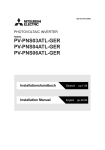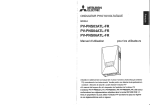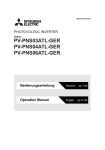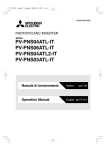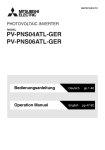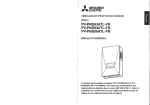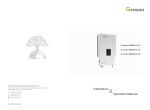Download Serie ATL manuale di installazione
Transcript
!"" MODELLO PV-PNS04ATL-IT PV-PNS06ATL-IT PV-PNS04ATL2-IT PV-PNS03ATL-IT Manuale di Installazione L'inverter fotovoltaico (inverter PV) PV-PNS04ATL-IT / PV-PNS06ATL-IT / PV-PNS04ATL2-IT / PV-PNS03ATL-IT è progettato in base alle normative definite dalla DK 5940. Pertanto, il proprietario può usare l'inverter PV solo nei paesi o nelle aree nelle quali queste normative sono in vigore. Italiano INVERTER FOTOVOLTAICO Sommario Pagina 1 Presentazione • • • • • • • • • • • • • • • • • • • • • 2 Precauzioni di sicurezza • • • • • • • • • • • • • • 3 Aspetto • • • • • • • • • • • • • • • • • • • • • • • • • • 3.1 Dimensioni • • • • • • • • • • • • • • • • • • • 3.2 Configurazione interna • • • • • • • • • • • 4 Parti e componenti incluse • • • • • • • • • • • • 5 Componenti,attrezzature e utensili richiesti 6 Requisiti 3 •4 •5 •5 •5 •6 •7 • • • • • • • • • • • • • • • • • • • • • • • • • • • • • • • • • • • • • • • • • • • • • • • • • • • • • • • • • • • • • • • • • • • • • • • • • • • • • • • • • • • • • • • • • • • • • • • • • • • • • • • • • • • • • • • • • • • • • • • • • • • • • • • • • • • • • • • • • • • • • • • • • • • • • • • • • • • • • • • • • • • • • • • • • • • • • • • • • • • • • • • • • • • • • • • • • • • • • • • • 8∼11 6.1 Posizione di installazione • • • • • • • • • • • • • • • • • • • • • • • • • • • • 8∼10 6.2 Requisiti per il collegamento al modulo PV • • • • • • • • • • • • • • • • • • 11 6.3 Requisiti per il collegamento alla rete • • • • • • • • • • • • • • • • • • • • • • 11 7 Installazione • • • • • • • • • • • • • • • • • • • • • • • • • • • • • • • • • • • • • • • • • 8 Collegamento dei cavi • • • • • • • • • • • • • • • • • • • • • • • • • • • • • • • • • • 8.1 Collegamento del modulo PV (ingresso DC) 8.2 Collegamento dell'uscita AC • • • • 8.3 Azioni successive al collegamento 9 Prova di funzionamento • • • • • 9.1 Verifiche pre-accensione • • • • • • • • • • • • • • • • • • • • • • • • • • • • • • • • • • • • • • • • • • • • • • • • • • • • • • • • • • • • • • • • • • • • • • • • • • • • • • • • • • • • • • • • • • • • • • • • 14∼20 14∼17 18∼19 • • • • 20 21∼24 • • • • 21 • • • • • • • • • • • • • • • • 21∼22 • • • • • • • • • • • • • • • • • • • • • • • • • • • • • 23∼24 9.2 Procedura della prova di funzionamento 9.3 Soluzione dei problemi • • • • • • • • • • • • • • 12∼13 10 Precauzioni per la manutenzione • • • • • • • • • • • • • • • • • • • • • • • • • • 25∼26 11 Appendice • • • • • • • • • • • • • • • • • • • • • • • • • • • • • • • • • • • • • • • • • • 27∼28 11.1 Selezione delle viti • • • • • • • • • • • • • • • • • • • • • • • • • • • • • • • • • • • 27 11.2 Selezione dei cavi • • • • • • • • • • • • • • 11.3 Capicorda e utensili di compressione 2 • • • • • • • • • • • • • • • • • • • • • • • • • • • • • • • • • • • 27∼28 • • • • 28 1 Presentazione Italiano L'inverter PV PV-PNS04ATL-IT/PV-PNS06ATL-IT/PV-PNS04ATL2-IT/PVPNS03ATL-IT converte l'energia elettrica a corrente continua generata dal modulo fotovoltaico (modulo PV) in energia elettrica a corrente alternata e la trasmette alla rete elettrica. Questo manuale di installazione illustra la procedura di installazione dell'inverter PV, la procedura di collegamento al modulo PV e alla rete elettrica e, infine, la prova di funzionamento dell'inverter PV. L'installazione dell'inverter PV PV-PNS04ATL-IT/ PV-PNS06ATL-IT/PVPNS04ATL2-IT / PV-PNS03ATL-IT è illustrata nel "Manuale di funzionamento dell'INVERTER FOTOVOLTAICO PV-PNS04ATL-IT/PV-PNS06ATL-IT/PVPNS04ATL2-IT/PV-PNS03ATL-IT". L'inverter PV PV-PNS04ATL-IT/PV-PNS06ATL-IT/PV-PNS04ATL2-IT/PVPNS03ATL-IT è conforme alle normative di cui alle direttive EMC e Bassa tensione. Inoltre, soddisfa le disposizioni definite nelle normative DK5940 e CEI. 3 2 Precauzioni di sicurezza Solo i tecnici qualificati possono intervenire sull'inverter PV. Il tecnico installatore può lavorare sull'inverter PV solo quando l'alimentazione è scollegata sia sul lato a corrente alternata che su quello a corrente diretta. ● I seguenti simboli denotano il tipo e il grado di pericolo che può derivare da un uso errato del dispositivo. Avverte del possibile pericolo di morte o di gravi che si corre se si utilizza il AVVERTENZA lesioni prodotto in modo errato. Non toccare alcuna parte del sistema con mani o altre parti del corpo bagnate. In caso contrario l’utente può subire scosse elettriche. Tra i cavi della serie di moduli PV scorre una tensione elevata. Proibito Non installare il prodotto all’esterno. In caso contrario possono verificarsi incendi o scosse elettriche. Mai installare, smontare o modificare l’inverter PV in modi alternativi a quelli illustrati nel presente manuale di installazione. In caso contrario possono verificarsi cadute, incendi e scosse elettriche. Non smontare o modificare Scollegare sempre le sorgenti di alimentazione sui lati a corrente alternata e continua prima di eseguire operazioni di manutenzione. Attendere sempre per almeno 30 minuti lo scaricamento dei condensatori integrati del prodotto prima di aprirne il pannello anteriore. In caso contrario l’utente può subire scosse elettriche. Collegare il conduttore di terra in modo sicuro. In caso contrario possono verificarsi incendi o scosse elettriche. Importante Indossare i guanti di protezione per le operazioni a bassa tensione quando si collegano i cavi dell’inverter PV. In caso contrario l’utente può subire scosse elettriche. Serrare sui cavi conduttori i capocorda a strozzamento alla coppia specificata. In caso contrario, possono verificarsi incendi. 4 3 Aspetto 3.1 Dimensioni 300 147 170 110 420 491,7 500 110 210 45 287 4×φ7 Unità: mm 3.2 Configurazione interna La figura qui sotto mostra la configurazione interna e i collegamenti con il pannello anteriore rimosso. 1 Area di reattanza 2 Area della centralina 1 3 Morsetto DC 4 Morsetto DC + 5 Morsetto uscita AC 6 Morsetto di messa a terra 2 7 Passacavi AC 3 8 Passacavi DC 9 Passacavi DC + 4 0 Jack modulare per interfaccia RS485 A Premistoppa dell'interfaccia RS485 5 B Interruttore RS485 6 +++ L N Numero di ingresso Numero dei premistoppa - D-C 0 DC AC Modello ON OFF B A PV-PNS03ATL-IT PV-PNS04ATL2-IT PV-PNS04ATL-IT PV-PNS06ATL-IT 7 8 9 5 nel terminale in c.c. del cavo in c.c. 2 4 3 6 Italiano ■Posizione dei fori di montaggio 4 Parti e componenti incluse L'inverter PV PV-PNS04ATL-IT/PV-PNS06ATL-IT/PV-PNS04ATL2-IT / PVPNS03ATL-IT dovrebbe includere le seguenti parti e componenti. Usare la tabella sottostante per verificare che la confezione contenga tutti gli elementi descritti. ① ② !" ! ## ③ φ ④ φ ⑤ ⑥ $ ⑦ ⑧ %& ' %( 6mm N. 1 2 3 4 5 6 7 8 Quantità Inverter PV 1 Piastra di montaggio 1 3 Guaina di protezione (φ20) 6 Guaina di protezione (φ10) 7 Fascetta fermacavo Manuale di funzionamento 1 1 Manuale di Installazione (questa pubblicazione) 1 Scheda di verifica della sezione dei cavi Elemento 6 Sì 5 Componenti, attrezzature e utensili richiesti Schema elettrico (per due stringhe di sistemi) ※In illustrazione viene presentato il caso in cui due collegamenti possiedono ciascuno un sezionatore di c.c. (DC). 2 6 5 Per la sicurezza durante le operazioni di installazione e manutenzione, includere sempre interruttori DC nel proprio impianto elettrico. 1 Parti da reperire 1 2 3 4 5 6 Cavo DC Cavo AC Capocorda di compressione per i cavi DC e AC Capocorda di compressione perio il cavo di terra Interruttore DC Interruttore AC 7 Vite di montaggio dell'inverter PV Vedere p.27 Vedere p.28 Vedere p.28 Vedere p.28 Selezionare viti appropriate ai materiali della parete. Vedere p.27 per ulteriori dettagli. * Se si utilizza un cavo da 10 mm2, è necessario procurarsi dei capocorda di compressione. Attrezzature e utensili per elettricisti Tronchesine Pinze Cacciavite a testa Phillips Utensile di compressione (specificato dal fabbricante) Strumento di misurazione dell'uscita Tester (per gamme superiori a 700 V c.c.) Tester della messa a terra * Preparare altri eventuali oggetti richiesti oltre a quelli specificati qui sopra. 7 Italiano 6 Requisiti Prima di iniziare l'installazione dell'inverter PV PV-PNS04ATL-IT / PVPNS06ATL-IT / PV-PNS04ATL2-IT / PV-PNS03ATL-IT, accertarsi che i seguenti requisiti siano soddisfatti. 6.1 Posizione di installazione Scelta e preparazione del luogo di installazione Quando si decide di installare l'inverter PV, seguire i requisiti qui sotto per ottenere il massimo delle prestazioni e per garantire un utilizzo sicuro dell'finverter PV. ●Installare l'inverter PV in interni. È PROIBITA l'installazione dell'inverter PV in luoghi che non possono essere separati da ambienti esterni, quali ad esempio rimesse aperte su un lato (ovvero, sprovviste di pareti o porte in grado di bloccare l'apertura). ●Montare l'inverter PV orizzontalmente su una parete verticale fissa e solida, abbastanza resistente da sostenerne il peso. Se la parete non è robusta a sufficienza, puntellarla. (L’unità PV-PNS04ATL-IT/PVPNS04ATL2-IT / PV-PNS03ATL-IT pesa 19 kg; la PV-PNS06ATL-IT 20 kg. (incl. la piastra di montaggio)(Vedere p.27.) ●Temperatura ambiente: -25-60˚C; umidità entro 30-90˚C. Montare l'inverter PV all'interno dell'edificio in posizioni esenti da possibili cambi di temperatura e, quindi, da fenomeni di condensa. ●Evitare l'illuminazione solare diretta. (Temperature estreme riducono le prestazioni). ●Montare l'inverter PV a un'altitudine inferiore ai 1.500 m sul livello del mare. ●Come illustrato qui sotto fornire uno spazio sufficiente attorno all'inverter PV per assicurare una corretta capacità di raffreddamento e spazio sufficiente ad agevolare la manutenzione. (Per l'installazione di due o più inverter PV, vedere p.10). 150 o maggiore Lato anteriore 1.000 o maggiore 150 o maggiore 150 o maggiore da 500 a 2.000 Unità: mm 8 ATTENZIONE ・All'esterno, o in luoghi analoghi (※PROIBITA l'installazione dell'inverter PV in luoghi che non possono essere separati da ambienti esterni, quali ad esempio rimesse aperte su un lato e sprovviste di pareti o porte in grado di bloccare l'apertura). ・Luoghi nei quali il dispositivo è esposto a luce solare diretta ・Luoghi angusti e privi di ventilazione. ・Luoghi nei quali il dispositivo è esposto al contatto con l'acqua. ・Luoghi nei quali l’umidità sia elevata in modo significativo, quali ad esempio le lavanderie o i bagni ・Luoghi nei quali sia presente una quantità eccessiva di vapore, vapori d'olio, fumo, polvere o sostanze corrosive ・Luoghi nei quali il dispositivo può essere esposto a fumi oleosi, quali ad esempio le cucine. ・Luoghi nei quali sono presenti gas infiammabili o esplosivi. ・Luoghi nei quali le installazioni sono vulnerabili alle vibrazioni o agli urti. ・Luoghi nelle vicinanze di materiali infiammabili ・Luoghi con condizioni inusuali e diverse da quelle indicate in precedenza (quali ad esempio a bordo di imbarcazioni o veicoli a motore) ・Luoghi nei quali si possono subire danni da aria salmastra Nota Evitare di installare l'inverter PV nei seguenti luoghi: (In caso contrario, l'inverter PV potrebbe indurre gli elettrodomestici a generare disturbi). ・Luoghi nei quali i disturbi o i disturbi di natura elettrica sono strettamente controllati ・Luoghi nei pressi di cavi e antenne radio-televisive 9 Italiano Evitare di installare l'inverter PV nei seguenti luoghi: (In caso contrario, l'inverter PV può subire guasti oppure può risultare impossibile usarlo in modo sicuro; inoltre, la garanzia del prodotto viene invalidata) (Precauzioni per l'installazione di più di un inverter PV) ●Installare gli inverter PV in una direzione trasversale con le seguenti spaziature. ●Dato che la generazione di calore complessiva è superiore a quella di un solo inverter PV, si devono mantenere scrupolosamente gli spazi intercorrenti tra i vari inverter PV installati. L'inverter PV genera calore durante la generazione di energia elettrica. Questo calore viene espulso dall'apertura di ventilazione (o scarico) sul suo lato sinistro. Se l'inverter PV 'B' viene installato immediatamente alla destra dell'inverter PV 'A', l'aria calda rilasciata da quest'ultimo può influire sull'altro inverter, producendo una riduzione delle capacità di raffreddamento. B A Aria calda ○ Aria calda (Giusto) 0 o maggiore 200 o maggiore × (Sbagliato) Distanza laterale tra gli inverter PV Distanza longitudinale tra gli inverter PV Unità: mm 10 6.2 Requisiti per il collegamento al modulo PV Si possono collegare all'inverter PV sino a tre stringhe. !"#$%!& !"#$%'!& !"#$%!& !"#($%!& !"#$%!& !"#$%'!& )) * !"#$%!& !"#($%!& ' ( ', $ +, $ ●Non collegare i moduli PV con un elettrodo DC+ o DC- messo a massa all'inverter PV. (Sarebbe causa di guasto dell'inverter PV.) ●Si deve sempre inserire un interruttore DC tra l'inverter PV e il modulo PV collegato per assicurare un funzionamento sicuro durante l'installazione o la manutenzione dell'inverter PV. 6.3 Requisiti per il collegamento alla rete Per il collegamento dell'inverter PV alla rete, è necessario ottemperare alle norme tecniche pertinenti, oltre ai requisiti specifici definiti dalla società produttrice di elettricità locale. ●Accertarsi che la rete elettrica alla quale si collega l'inverter PV soddisfi i seguenti requisiti Requisiti di collegamento Campo delle tensioni 184−276 V Gamma delle frequenze 49,7−50,3 Hz ●Per minimizzare le perdite di potenza, si devono utilizzare cavi con una sezione appropriata alla loro lunghezza. ●Si deve sempre inserire un interruttore AC tra la rete e l'inverter PV. 11 Italiano ●Accertarsi che le dimensioni e i requisiti dei moduli PV da collegare soddisfino i requisiti di ingresso DC dell'inverter PV. (I moduli attivi devono soddisfare i seguenti requisiti di ingresso DC). 7 Installazione Quanto segue illustra l'installazione dell'inverter PV. <Installazione della piastra di montaggio> ●Selezionare viti appropriate per i materiali della parete. (Vedere p. 27 "Appendice" per ulteriori dettagli). Vite (serrare parzialmente) 1. Serrare (parzialmente) in posizione una vite nel foro centrale della sezione superiore della piastra di montaggio ●La vite deve essere in posizione perpendicolare rispetto alla parete. 1 Foro di montaggio 2. Sospendere la piastra di montaggio alla vite serrata parzialmente. Regolare la posizione verticale della piastra. 1. Serrare sei viti nei rimanenti fori di montaggio per fissare la piastra alla parete. 2 3 2. Serrare a fondo la vite serrat parzialmente. Accertarsi che la piastra di montaggio sia in piano. 12 <Montaggio dell'inverter PV> 1. Rimuovere due viti sul fondo dell'inverter PV. Italiano 1 Inverter PV Vite Aggancio Inverter PV 1. Inserire l'aggancio che si trova nella sezione superiore del lato posteriore Scanalatura dell'inverter PV nella scanalatura presente nella piastra di montaggio. Questo monta l'inverter PV sulla piastra. 2 2. Installare le due viti rimosse nella fase 1 qui sopra per fissare l'inverter PV sulla piastra. ● Coppia di serraggio : 1,4-1,6 N•m Vite 3 Piastra di montaggio Accertarsi che l'inverter PV non sia montato in modo da consentire il suo movimento sulla piastra di montaggio o sulla parete. 13 8 Collegamento dei cavi 8.1 Collegamento del modulo PV (ingresso DC) Seguire la procedura indicata prima di collegare l'ingresso DC all'inverter PV. 1. Verificare i valori corretti di polarità e tensione massima di ogni modulo PV. (PV-PNS03ATL-IT) ●Il modulo PV presenta un'elevata tensione a corrente diretta molto pericolosa. Seguire con la massima attenzione le precauzioni di sicurezza. 2. Accertarsi che gli interruttori AC e DC siano entrambi in posizione OFF. ●Prestare attenzione a non portare acciden(PV-PNS04ATL2-IT / 04ATL-IT / 06ATL-IT) talmente gli interruttori AC e DC in posizione ON durante il funzionamento. Il numero dei terminale di ingresso può variare tra PV-PNS03ATL-IT e PVPNS04ATL2-IT / PV-PNS04ATL-IT /PV-PNS06ATL-IT. Seguire la procedura indicata qui sotto per collegare i cavi del modulo PV (ingresso DC). 1 Portare l'interruttore DC in posizione OFF. ① Rimuovere le 2 viti che fissano la parte inferiore del pannello anteriore. ② Pannello anteriore ③ 2 ③ Inoltre, rimuovere il conduttore di messa a terra elettrica dal terminale Terminale a linguetta di a linguetta di messa a terra. messa a terra Conduttore di terra ① 3 ② Rimuovere il pannello anteriore. Vite ●Individuare la parte rivestita di resina del conduttore di terra e tirarlo verso la direzione indicata nell'illustrazione. Verificare la sezione di un cavo DC usando la Scheda di verifica della sezione dei cavi scheda di verifica della sezione dei cavi (accessorio). Inserire i cavi DC nel foro dell'accessorio. Questa operazione consente di 6mm determinare se la sezione del cavo è inferiore o superiore a 6 mm. (A sezioni del cavo difCavo DC ferenti corrispondono metodi di collegamento differenti. Vedere p. 16-6). 14 Morsetto DC - DC DC ※Per far correre due o più cavi attraverso il passacavi, innanzitutto allentare il passacavi e quindi rimuovere il cappuccio protettivo. Cavo DC + Cavo DC + (Passacavi nero) Passacavi DC (di sezione inferiore) Cavo DC - Cappuccio protettivo Conduttore circa 1 mm 5 Cavo DC - (Passacavi argento) Fissare un capocorda di compressione, adatto alla sezione del cavo, ai rispettivi cavi DC. (Vedere p.28 "Appendice"). Fermaglio Cavo DC + 15 Italiano 4 Morsetto DC + Far scorrere il cavo del modulo PV (ingresso DC) estendendolo dall'interruttore DC attraverso il passacavi DC (di sezioni minori) nella sezione inferiore dell'inverter PV. Per i cavi DC > 6 mm Morsetto DC - Morsetto DC + 1. Rimuovere la fascetta gruppo cavi. 2. Far correre il cavo DC attraverso la guaina di protezione (φ10). 3. Fissare la guaina, con il cavo al suo interno, usando l'accessorio apposito. 4. Collegare il cavo DC al morsetto. ● Coppia di serraggio : 2,6-3,4 N•m ● Prestare attenzione a non confondere il cavo DC + con il cavo DC -. ● Verificare che sia installata la guaina di protezione. Questa è necessaria per evitare che il cavo subisca danni e per impedire che un eventuale incendio possa estendersi. Fascetta gruppo cavi Fascetta fermacavo Guaina di protezione Fascetta gruppo cavi 6 Per i cavi DC ≦ 6mm 1. Rimuovere la fascetta gruppo cavi. 2. Far correre i cavi DC in un fascio attraverso la guaina di protezione Morsetto DC - Morsetto DC + (φ20). 3. Installare il cavo DC sul morsetto. ● Coppia di serraggio : 2,6-3,4 N•m ● Evitare di confondere il cavo DC + con il cavo DC -. Guaina di protezione 4. Collegare il cavo DC al morsetto. ● Coppia di serraggio : 1,4-1,6 N•m ● Verificare che sia installata la guaina di protezione. Questa è necessaria per evitare che il cavo subisca danni e per impedire che un eventuale incendio possa estendersi. Fascetta gruppo cavi 16 Fissare i passacavi DC. Morsetto DC - Morsetto DC + ●Coppia di serraggio : 3 N•m ●Evitare di esercitare tensione sui cavi. Italiano 7 Passacavi DC Morsetto DC - Morsetto DC + 8 Portare l'interruttore DC in posizione ON e quindi verificare la tensione corretta sui morsetti DC + e DC - del morsetto di ingresso DC. ●Accertarsi che la tensione sia compresa tra 200 e 700 V. Accertarsi che il cappuccio protettivo rimanga sul passacavo inutilizzato. 9 Portare l'interruttore DC in posizione OFF. 10 17 8.2 Collegamento dell'uscita AC Usare la procedura seguente prima di collegare l'inverter PV all'uscita AC. 1. Verificare la rete per individuare il valore corretto di tensione. ●Accertarsi che la tensione sia compresa tra 184 e 276 V. 2. Accertarsi che gli interruttori AC e DC siano in posizione OFF. ●Prestare attenzione a non portare accidentalmente gli interruttori AC e DC in posizione ON durante il funzionamento. Per collegare il cavo AC all'inverter PV, usare la procedura seguente. 1. Far correre il cavo AC attraverso il passacavi AC (di sezione maggiore) sul fondo dell'inverter PV, quindi fissare un capocorda di compressione. Conduttore circa 1 mm Fermaglio 2. Installare il capocorda di compres- LN 1 sione sul conduttore di terra (PE). ●Fare attenzione a non confondere i cavi AC e DC. Cavo AC Passacavi AC (di sezione superiore) 2 Far correre i cavi AC e il conduttore di terra (PE) attraverso la guaina di protezione (φ20) e collegare i cavi L ed N rispettivamente ai morsetti L ed N della morsettiera di uscita AC. ●Prestare attenzione a non confondere la fase L con la fase N. ●Coppia di serraggio : 2,6-3,4 N•m 18 Collegare il conduttore di terra (PE) morsetto di messa a terra ( ) posto sul lato destro del morsetto di uscita Morsetto di messa a terra L N AC dell'inverter PV. ●Coppia di serraggio : 0,9-1,1 N•m Conduttore di terra Fissare la guaina di protezione, con i cavi DC al suo interno, usando l'accessorio apposito. Guaina di protezione L N 4 ●Verificare che sia installata la guaina di protezione. Questa è necessaria per evitare che il cavo subisca danni e per impedire che un eventuale incendio possa estendersi. Fascetta fermacavo L N Fissare il passacavi AC. ●Coppia di serraggio : 5 N•m 5 Passacavi AC Accendere il disconnettore in AC, quindi verificare se nei terminali L-N ed L-PE del lato in AC è presente la tensione corretta. L N 6 7 PE ●Accertarsi che la tensione sia compresa tra 184 e 276 V. Portare l'interruttore AC in posizione OFF. 19 Italiano 3 8.3 Azioni successive al collegamento 1 Fissare il passacavi AC e i passacavi DC (+ e -), in modo che le aperture risultino ben chiuse. Pannello anteriore ① ① Agganciare per montare saldamente il pannello anteriore sull’inverter PV. Collegare il conduttore di messa a terra elettrica sotto il pannello al terminale a linguetta di messa a terra. Terminale a linguetta di messa a terra ① 2 ●Chiudere il pannello prestando attenzione a non causare problemi con i cavi. Conduttore di terra ② Vite ② Fissare le due viti sul fondo del pannello. ●Coppia di serraggio: 0,9-1,3 N•m 20 9 Prova di funzionamento Quanto segue illustra la prova di funzionamento dell'inverter PV. ●Il cavo AC è stato collegato correttamente. ●Tutti i cavi DC che si estendono dalle stringhe sono stati collegati. Inoltre, tutti i passacavi inutilizzati sono chiusi con cappucci di protezione applicati sul fondo dell'inverter PV. ●Il pannello anteriore viene fissato in modo sicuro all'inverter PV. 9.2 Procedura della prova di funzionamento La seguente procedura dovrebbe essere eseguita dopo essersi accertati che le modulo PV illuminate e non si verifichi alcun blackout. Schermo a cristalli liquidi (LCD) LED ERROR Pulsante Pulsante Pulsante POWER MODE SELECT Pulsante ENTER 1 Portare l'interruttore DC in posizione ON. Schermo LCD Controllo/Azione Attendere per 20 secondi. A questo punto sullo schermo LCD dovrebbe apparire il messaggio mostrato nella figura a sinistra. (Se non compare alcuna informazione, vedere p. 23 "Soluzione dei problemi"). 21 Italiano 9.1 Verifiche pre-accensione 2 Portare l'interruttore AC in posizione ON. Schermo LCD Controllo/Azione 1. Premere e tenere premuto il pulsante POWER per due secondi o più e quindi accertarsi che siano visualizzate le informazioni che indicano l'avvenuto avvio dell'inverter PV. AVV I O (Se si accende il LED ERROR oppure se lo schermo LCD visualizza un codice di errore, vedere p.23 "Soluzione dei problemi"). I N FUNZ I ONE 0 kWh 2. Attendere per circa 5 minuti sino a che l'inverter si attiva. Controllare se lo schermo LCD visualizza o meno il livello di generazione di energia elettrica. 3 Completare la prova di funzionamento. Schermo LCD Controllo/Azione 1. Premere e tenere premuto il pulsante POWER per due secondi o più e quindi accertarsi che sullo schermo LCD siano visualizzate le informazioni mostrate nella figura di sinistra (----). 2. Portare gli interruttori AC e DC in posizione OFF. 4 Esecuzione dell'AUTO TEST. L'inverter PV prevede una modalità AUTO TEST; questa modalità consente la verifica automatica del corretto funzionamento delle modalità OVR, UVR, OFR o UFR. La funzionalità va attivata soltanto quando l'inverter PV è in esecuzione con la rete attiva collegata e un'illuminazione solare sufficiente. La funzione è indisponibile quando l'inverter PV è in stato di Stop o Attesa. Per la procedura, fare riferimento alla sottosezione '5.3.6 Funzionamento in modalità AUTO TEST' del manuale di funzionamento. 22 9.3 Soluzione dei problemi Schermo LCD Sintomi Nessuna informazione visualizzata sullo schermo LCD. Sullo schermo LCD è visualizzato un messaggio di errore oppure si accende il LED ERROR. Controllo/Azione ●La tensione del modulo PV non è (correttamente) applicata al morsetto di ingresso DC dell'inverter PV. ●L'interruttore DC è in posizione OFF. ●Controllare se sul display a cristalli liquidi è apparso un messaggio d’errore (o un codice d’errore) e se così, seguire le istruzioni. ERRORE E -** Se compare il seguente messaggio di errore, seguire le istruzioni. Schermo LCD Errore Rimedio ERRORE E - 6 6 Verificare che la tensione tra i La rete è difetmorsetti L ed N sia compresa tra tosa o collegata in modo errato. 184 e 276 V c.a. Se si rileva un valore di tensione non conforme, verificare che i collegamenti elettrici siano fissati correttamente. BLACKOUT Esiste una Verificare che l'interruttore AC sia perdita di poten- in posizione OFF. za nella rete o sull'interruttore AC. 23 Italiano L'inverter PV dispone di un sistema autodiagnostico integrato che visualizza automaticamente sullo schermo LCD eventuali guasti rilevati. Questo significa che eventuali guasti dell'inverter PV possono essere notificati rapidamente al proprietario, che riceve anche informazioni sull'errata installazione del sistema PV e/o dell'inverter PV. Schermo LCD ERRORE E - 2 0 ERRORE E - 2 9 ERRORE E - 3 5 Nessuno Errore Rimedio Il modulo PV genera una tensione superiore a 700 V. Troppi moduli PV sono collegati in serie. Regolare il numero dei moduli sino a ottenere un livello corretto. Si riscontra un Verificare il corretto isolamento guasto di messa dei moduli PV e dei cavi. a terra. Accertarsi che la rete sia collegata correttamente ai morsetti L ed N. Un cattivo colL'inverter PV deve essere riparalegamento ai to. Contattare il rivenditore. morsetti ha bruciato il fusibile termico. L'inverter PV riceve una tensione insufficiente, oppure gli interruttori sono in posizione OFF. Non viene visualizzata alcuna informazione quando i moduli PV non sono illuminati dalla luce solare, come avviene nelle prime ore del mattino o durante la notte. Questo comportamento è del tutto normale. ●Accertarsi che i cavi DC siano correttamente collegati ai morsetti (+) e (-). ●Accertarsi che gli interruttori siano in posizione ON. Se quanto indicato qui sopra non risolve il problema, oppure se compaiono messaggi di errore non trattati da questa sezione, contattare il rivenditore. 24 10 Precauzioni per la manutenzione L’inverter PV è attraversato da un’alta tensione a corrente continua proveniente dal modulo PV. Il pannello anteriore dell’inverter PV può essere aperto solo da tecnici qualificati. <Apertura del pannello anteriore> 1 2 3 Portare l'interruttore AC in posizione OFF. Portare l'interruttore DC in posizione OFF. Attendere per 30 minuti. ●Questo è necessario per scaricare i condensatori integrati nell'inverter PV. ① Rimuovere le 2 viti che fissano il pannello anteriore alla parte inferiore. ② Pannello anteriore ③ 4 ③ Inoltre, rimuovere il conduttore di Terminale a messa a terra elettrica dal terminale linguetta di a linguetta di messa a terra. messa a terra Conduttore di terra ① Vite ② Rimuovere il pannello. ● Individuare la parte rivestita di resina del conduttore di terra e tirarla verso la direzione indicata nell'illustrazione. 25 Italiano AVVERTENZA <Chiusura del pannello anteriore> 1 Accertarsi che gli interruttori AC e DC siano in posizione OFF. ① Agganciare per montare saldamente il pannello anteriore sull’inverter PV. Collegare il conduttore di messa a Terminale a terra elettrica sotto il pannello al terlinguetta di messa a terra minale a linguetta di messa a terra. Pannello anteriore ① ① ●Chiudere il pannello prestando attenzione a non causare problemi con i cavi. 2 Conduttore di terra ② Fissare le due viti sul fondo del pannello. ●Coppia di serraggio: 0,9-1,3 N•m ② Vite 26 11 Appendice 11.1 Selezione delle viti φ5 50mm φ3 Vite Diametro del foro Spessore del pannello ≧18mm 50mm Φ5 1. Per pareti di legno Vite Vite Tassello Diametro del foro Forza compressiva del blocco φ5 55mm Produttore: fischerwerke Prodotto: Universal plug UX Tipo: UX6×50 mm φ6 Spessore del blocco ≧11,7N/mm2 ≧60mm 55mm Φ5 2. Per pareti di calcestruzzo Vite Tassello 11.2 Selezione dei cavi 1. Cavo DC I cavi DC devono soddisfare le seguenti specifiche. Si devono selezionare cavi adatti alla gamma di tensioni e correnti generate dai moduli PV collegati. !"# $ ## % !"# &' ## (( ) !"# & ## & %* +,∼&(( φ+,∼&(( 27 Cavo DC Italiano Ogni vite deve sopportare un carico massimo di 1176[N] quando si monta a parete l'inverter PV. Posizioni e tipo di viti devono essere selezionate appositamente. Le scelte possibili includono: 2. Cavo AC I cavi AC devono soddisfare le seguenti specifiche. Si devono selezionare cavi adatti alla massima uscita dei moduli PV collegati. $" !"# # %& $& $" ∼ '' ∼'' # φ∼ '' φ ∼'' Cavo AC 11.3 Capicorda e utensili di compressione Si dovrebbero applicare capicorda a compressione adatti alla sezione del cavo conduttore. I capicorda più diffusi includono: Produttore: Gustav Klauke GmbH Sezione trasversale del conduttore Tipo di capicorda a compressione Tipo di utensile di compressione 10mm2 K16.K50 6525 . 6526 2 4∼6mm K10.K14.K15.K50.K82.K85 6505 . 6506 2,5mm2 K10.K14.K15.K50.K81.K82.K85 6305 . 6306 La morsettiera integrata sull'inverter permette l'uso di capicorda a compressione delle seguenti dimensioni. Dimensioni utili per la testa del capocorda a compressione Dimensioni φD W Gamma applicabile ≧ 5,1mm ≦ 11mm Capocorda a compressione W φD 28 PHOTOVOLTAIC INVERTER MODEL Installation Manual The photovoltaic inverter (PV inverter) PV-PNS04ATL-IT / PV-PNS06ATL-IT / PV-PNS04ATL2-IT / PV-PNS03ATL-IT is designed to the regulations stipulated in DK 5940. Therefore, the owner may use the PV inverter only in countries or areas where such regulations are applicable. English PV-PNS04ATL-IT PV-PNS06ATL-IT PV-PNS04ATL2-IT PV-PNS03ATL-IT Table of Contents Page 1 Introduction • • • • • • • • • • • • • • • • • • • • • • • • • 2 Safety Precautions • • • • • • • • • • • • • • • • • • • • 3 Appearance • • • • • • • • • • • • • • • • • • • • • • • • • 3.1 Dimensions • • • • • • • • • • • • • • • • • • • • • 3.2 Internal Configuration • • • • • • • • • • • • • • 4 Included Components and Parts • • • • • • • • • • 5 Required Components, Equipment and Tools 6 Requirements 31 • 32 • 33 • 33 • 33 • 34 • 35 • • • • • • • • • • • • • • • • • • • • • • • • • • • • • • • • • • • • • • • • • • • • • • • • • • • • • • • • • • • • • • • • • • • • • • • • • • • • • • • • • • • • • • • • • • • • • • • • • • • • • • • • • • • • • • • • • • • • • • • • • • • • • • • • • • • • • • • • • • • • • • • • • • • • • • • • • • • • • • • • • • • • • • • • • • • • • • 36∼39 6.1 Installation Location • • • • • • • • • • • • • • • • • • • • • • • • • • • • • • • 36∼38 6.2 Requirements for Connection to PV Module • • • • • • • • • • • • • • • • • 39 6.3 Requirements for Connection to Grid • • • • • • • • • • • • • • • • • • • • • • 39 7 Installation • • • • • • • • • • • • • • • • • • • • • • • • • • • • • • • • • • • • • • • • • • • 8 Connecting Cables • • • • • • • • • • • • • • • • • • • • • • • • • • • • • • • • • • • • 8.1 PV Module (DC Input) Connection • • • • • • • • • • • • • • • • • • • • • 40∼41 42∼48 42∼45 8.2 Connection of AC Output • • • • • • • • • • • • • • • • • • • • • • • • • • • • 46∼47 8.3 Actions After Connection • • • • • • • • • • • • • • • • • • • • • • • • • • • • • • • 48 9 Test Run • • • • • • • • • • • • • • • • • • • • • • • • • • • • • • • • • • • • • • • • • • • • 49∼52 9.1 Check Before Turning On • • • • • • • • • • • • • • • • • • • • • • • • • • • • • • • 49 • • • • • • • • • • • • • • • • • • • • • • • • • • • • • • • 49∼50 • • • • • • • • • • • • • • • • • • • • • • • • • • • • • • • • • • 51∼52 9.2 Test Run Procedure 9.3 Troubleshooting 10 Precautions for Maintenance • • • • • • • • • • • • • • • • • • • • • • • • • • • • • 53∼54 11 Appendix • • • • • • • • • • • • • • • • • • • • • • • • • • • • • • • • • • • • • • • • • • • 55∼56 11.1 Selecting Screws • • • • • • • • • • • • • • • • • • • • • • • • • • • • • • • • • • • • 55 11.2 Selecting Cables • • • • • • • • • • • • • • • • • 11.3 Crimping Terminals and Crimping Tools 30 • • • • • • • • • • • • • • • • • • • • • • • • • • • • • • • 55∼56 • • • • 56 1 Introduction English The PV inverter PV-PNS04ATL-IT / PV-PNS06ATL-IT / PV-PNS04ATL2-IT / PV-PNS03ATL-IT converts direct-current energy generated by PV modules into alternating-current energy for supplying the grid. This Installation Manual illustrates the installation procedure for the PV inverter, the connection procedure for the PV module and grid, and test running of the PV inverter. Operation of the PV inverter PV-PNS04ATL-IT / PV-PNS06ATL-IT / PV-PNS04ATL2-IT / PV-PNS03ATL-IT is illustrated in the separate "PHOTOVOLTAIC INVERTER PV-PNS04ATL-IT / PV-PNS06ATL-IT / PV-PNS04ATL2-IT / PV-PNS03ATL-IT Operation Manual". The PV inverter PV-PNS04ATL-IT / PV-PNS06ATL-IT / PV-PNS04ATL2-IT / PV-PNS03ATL-IT complies with the regulations stipulated in EMC and Low Voltage Directives. It also meets the provisions defined in DK5940 and CEI. 31 2 Safety Precautions Only qualified technicians may work on the PV inverter. The installer may work on the PV inverter only when the power sources are disconnected at the alternating- and direct-current sides. ●The following symbols denote the type and degree of danger that may result from incorrect use. WARNING Alerts you to potential death or serious injury anticipated if worked on the PV inverter in a wrong manner. Do not touch any part of the system with wet hands or body. Electric shock may result. High voltages are present among the PV module array cables. Prohibited Do not install the PV inverter outdoors. Fire or electric shock may result. Never install, disassemble or modify the PV inverter in ways other than those illustrated in the installation manual. Do not disassemble or modify Falling, electric shock or fire may result. Always disconnect the power sources at the alternating- and direct-current sides before performing maintenance. Always wait for 30 minutes to discharge the capacitors built in the PV inverter before opening its front panel. Electric shock may result. Connect the earth lead securely. Fire or electric shock may result. Important Wear insulated rubber gloves for low-voltage operations when wiring PV inverter. Electric shock may result. Securely press-fit to tighten crimp terminals with specified torques on lead wires. Fire may result. 32 3 Appearance 3.1 Dimensions ■Location of mounting holes 147 170 4×φ7 420 491.7 500 300 110 Unit: mm 3.2 Internal Configuration The figure below shows the internal configuration and connections with the front panel removed. 1 2 1 3 4 5 6 7 ! "# 2 3 8 ! "# 9 ! "# 4 0 $# %& ' () ' A () ' "# 5 B () *+ 0 , ,-- B A ! ' ! ' $# ! "#* 6 7 8 9 33 English 110 210 45 287 4 Included Components and Parts The PV inverter PV-PNS04ATL-IT / PV-PNS06ATL-IT / PV-PNS04ATL2-IT / PV-PNS03ATL-IT should be packaged with the following components and parts. Please use the following table to make sure that all items are included. ① ② " # ③ φ ④ φ ⑤ ⑥ ⑧ ⑦ ! ! 6mm No. 1 2 3 4 5 6 7 8 Item PV inverter Mounting plate Protective tube (φ20) Protective tube(φ10) Cable tie Operation Manual Installation Manual (This publication) Cable Diameter Check Sheet 34 Quantity 1 1 3 6 7 1 1 1 Yes 5 Required Components, Equipment and Tools Electrical System Connection Diagram (for two string system) ※The illustration shows the case where two strings have one DC disconnector each. PV inverter String 1 PV module 2 AC cable - + 5 DC disconnector For safety installation and maintenance work, always provide a DC disconnector(s) in your electrical system. 6 AC disconnector 1 DC cable Earth lead Parts to be procured 1 2 3 4 DC cable AC cable Crimping terminai for AC and DC cable Crimping terminai for Earth lead 5 6 DC disconnector AC disconnector 7 PV inverter mounting screw See p.55 See p.56 See p.56 See p.56 Select appropriate screws for wall material. See p.55 for details. *Crimping terminals need be procured if you use 10mm2 cable. Equipment and tools for electric work Nippers Pliers Phillips screwdriver Crimping tool (as specified by the manufacturer) Output measuring instrument Tester Earth Tester (for ranges higher than 700 VDC) * Prepare any required items other than the above. 35 English String 2 6 Requirements Before beginning installation of the PV inverter PV-PNS04ATL-IT / PVPNS06ATL-IT / PV-PNS04ATL2-IT / PV-PNS03ATL-IT, make sure that the following requirements are met. 6.1 Installation Location Selecting and preparing installation location When installing the PV inverter, follow the requirements below to achieve optimum performance of, and to ensure safe use of the PV inverter. ●Install the PV inverter indoors. It is PROHIBITED to install the PV inverter in places unable to be separated from outdoor environment, such as garage open at one side (i.e., no wall or door able to block such side, provided). ●Mount the PV inverter horizontally on a firm and sturdy vertical wall strong enough to bear its weight. If the wall is not strong enough, shore up the wall. (The PV-PNS04ATL-IT / PV-PNS04ATL2-IT / PVPNS03ATL-IT weights 19kg; PV-PNS06ATL-IT 20kg. (incl. mounting plate))(See p.55.) ●Ambient temperature: -25-60℃; humidity within 30-90%. Mount the PV inverter inside the building where no possible condensation due to temperature change occurs. ●Avoid direct sunlight. (Extremely high temperature deteriorates its performance.) ●Install the PV inverter at a place lower than 1,500 m above sea level. ●As illustrated below provide enough space around the PV inverter to ensure proper cooling capability and room to facilitate maintenance. (For installing two or more PV inverter, see p.38.) 150 or wider Front 1,000 or wider 150 or wider 150 or wider 500 to 2,000 Unit: mm 36 CAUTION Do not install the PV inverter in the following places: (Otherwise, the PV inverter may fail or its safe use may be impeded. The product warranty shall also be voided.) ・Outdoors, or places similar to outdoors (※It is PROHIBITED to install the PV inverter in places unable to be separated from outdoor environment, such as garage open at one side, no wall or door able to block such side, ・Places where it is exposed to direct sunlight ・Narrow places lacking ventilation ・Places where it is exposed to water ・Places where humidity is significantly high such as lavatory or bathroom ・Places where excessive steam, oil vapor, smoke, dust, or corrosive substance is present ・Places where it is exposed to oily smoke, such as a kitchen ・Places where explosive or flammable gases are present ・Places installations are exposed to vibration or shock ・Places in the vicinity of flammable materials ・Places with unusual conditions other than those indicated above (such as seafaring vessels or motor vehicles) ・Places where damage from salt air could occur Note Avoid installing the PV inverter in the following places: (Otherwise, the PV inverter might cause appliances to generate noises.) ・Places where noises or electric noises are under strict control ・Places in the vicinity of television or radio antennas or cables 37 English provided.) (Precautions for installing more than one PV inverter) ●Install the PV inverters in a transverse direction with space between them as follow. ●Since overall heat divergence is larger than that when one PV inverter is installed, the gap between the installed PV inverters must be fully kept. The PV inverter generates heat as it generates electric power while discharging the heated air from the ventilation (or exhaust) opening on its left side. If PV inverter 'B' is installed immediately to the right of PV inverter 'A', hot air released from 'B' could affect 'A', resulting in lower cooling performance. B A Hot air ○ Hot air (Right) 0 or wider 200 or wider × (Wrong) Lateral distance between PV inverters Longitudinal distance between PV inverters Unit: mm 38 6.2 Requirements for Connection to PV Module Up to three strings are connectable to the PV inverter. ●Make sure that the sizes and requirements for the PV modules you are connecting meet the DC input requirements for the PV inverter. (Active modules must satisfy the following DC input requirements.) 3250W 4300W 6000W 12.0A DC 18.0A DC ●Do not connect the PV modules with an earthed DC+ or DC- electrode to the PV inverter. (Damage to the PV inverter may result.) ●A DC disconnector must always be inserted between the PV inverter and connected PV modules to avoid electric shock during installation of, or maintenance work on, the PV inverter. 6.3 Requirements for Connection to Grid For connection of the PV inverter to the grid, the relevant technical regulations, as well as specific requirements defined by the local utility company, must also be complied with. ●Make sure that the grid to which you are connecting the PV inverter meets the requirements as follows. Voltage range Frequency range Connection requirements 184−276 V 49.7−50.3 Hz ●In order to minimize power losses, cables with cross sectional area appropriate to their lengths must be used. ●An AC disconnector must always be inserted between the grid and the PV inverter. 39 English DC Input Requirements PV-PNS03ATL-IT PV-PNS04ATL2-IT Recommended generator power PV-PNS04ATL-IT PV-PNS06ATL-IT Max. DC voltage (per string) 700 VDC Min. DC voltage (per string) 150 VDC PV-PNS03ATL-IT PV-PNS04ATL2-IT Max. input current (sum of each string) PV-PNS04ATL-IT PV-PNS06ATL-IT 7 Installation The following illustrates the installation of the PV inverter. <Installing the mounting plate> ●Select appropriate screws for wall material. (See p.55 "Appendix" for details.) Screw (tentatively-fasten) 1. Tentatively fasten one screw in the top center hole of the mounting plate. ●The screw should be perpendicular to the wall. 1 Mounting hole 2. Hang the mounting plate on the tentatively-fastened screw. Adjust the mounting plate vertically. 1. Tighten six screws in the remaining mounting holes to fix the plate on the wall. 2 3 2. Tighten the tentatively-fastened screw. Make sure that the mounting plate is on the level. 40 <Mounting the PV Inverter> 1. Remove two screws from the bottom of the PV inverter. 1 English PV inverter Screw Overhang 1. Securely place the overhang in the upper section of the back of the PV Groove inverter into the groove of the mounting plate. PV inverter 2. Fix the PV inverter on the mounting plate with two screws which were removed in 1-1. 2 ●Tightening torque:1.4-1.6 N・m Screw 3 Mounting plate Make sure that the PV inverter does not jounce on the mounting plate or wall. 41 8 Connecting Cables 8.1 PV Module (DC Input) Connection Perform the following procedure before connecting the DC input to the PV inverter. 1. Check polarities and maximum voltage of each PV module string. ●Very dangerous high direct-current voltage is present on the PV module. Follow safety precautions to the fullest. (PV-PNS03ATL-IT) 2. Make sure that AC and DC disconnectors are off. ●Take care not to allow to turn on the AC and DC (PV-PNS04ATL2-IT / 04ATL-IT / 06ATL-IT) disconnectors unexpectedly during operation. The number of the input terminals differs between PV-PNS03ATL-IT and PVPNS04ATL2-IT / PV-PNS04ATL-IT / PV-PNS06ATL-IT. Follow the procedure below to connect the cables extending from the PV module (DC input). 1 Turn off the DC disconnector. ② Front panel ① Remove the two screws fixing the front panel from the bottom. ② Remove the front panel. ③ 2 Earth lead ① 3 Earth tab terminal ③ Also, remove the earth lead from the earth tab terminal. ●Pick up the resin-coated section of earth lead, pull it to the direction indicated in the illustration. Screw Check the cable diameter of a DC cable Cable diameter check sheet using the accessory cable diameter check sheet. Insert the DC cables into the hole of the cable diameter check 6mm sheet. This determines whether its diameter is smaller or larger than 6mm. DC Cable (Different connection method for different cable diameter. See p.44-6.) 42 DC - terminal 4 DC + terminal DC DC Run the PV module (DC input) cable extending from the DC disconnector through the DC cable gland (of smaller diameters) in the lower section of the PV inverter. ※To run two or more cables, first loosen the cable gland and then remove the protective cap. DC - Cable Protective cap Core lead approx. 1 mm 5 DC - cable (Silver gray) gland Securely attach crimping terminals , suited to the cable diameter, to the DC cables respectively. (See p.56 "Appendix".) Press-fit mark DC + cable 43 English DC + Cable DC + cable (Black) gland DC cable gland (of smaller diameter) For DC cables > 6mm 1. Remove the cord clip. DC - terminal DC + terminal 2. Run the DC cable through the protective tube (φ10). 3. Tie up the tube with the cable tie, with the DC cable held therein. 4. Fix the DC cable on the terminal. ●Tightening torque: :2.6-3.4 N・・m ●Avoid confusing the DC + with the DC - cable. ●Ensure that the protective tube is installed. This is required to prevent the cable from being damaged or arrest the spread of possible fire. Cord clip Cable tie Protective tube Cord clip 6 For DC cables ≦ 6mm 1. Remove the cord clip. 2. Run the DC cables in a bundle DC - terminal DC + terminal through the protective tube (φ20). 3. Install the DC cables on the terminal. :2.6-3.4 N・・m ●Tightening torque: ●Avoid confusing the DC + with the DC - cable. Protective tube 4. Fasten the cord clip around the protective tube in which the cables are held. Cord clip ●Tightening torque: :1.4-1.6 N・・m ●Ensure that the protective tube is installed. This is required to prevent the cable from being damaged or arrest the spread of possible fire. 44 Fasten the DC cable glands. DC - terminal DC + terminal ●Tightening torque:3 N・m ●Avoid exerting tension on the cables. 7 DC - terminal DC + terminal Turn on the DC disconnector, and then check for the correct voltage between terminals DC + and DC - on the DC input terminal. ●Make sure the voltage is of 200 to 700V. 8 Make sure that the protective cap remains on the unused cable gland. 9 Turn off the DC disconnector. 10 45 English DC Cable gland 8.2 Connection of AC Output Perform the following procedure before connecting the PV inverter to the AC output. 1. Check the grid for the correct voltage. ●Make sure the voltage is of 184 to 276V. 2. Make sure that AC and DC disconnectors are off. ●Take care not to allow any power to flow unexpectedly during operation. Perform the following procedure to connect the AC cable to the PV inverter. Core lead approx. 1 mm Press-fit mark 2. Assuredly install the crimping termi- LN 1 1. Run the AC cable through the AC cable gland (of larger diameter) on the bottom of the PV inverter, then firmly attach a crimping terminal. nal on the earth (PE) conductor. ●Avoid confusing AC and DC cables. AC cable AC cable gland (of larger diameter) AC output terminal 2 Protective tube L L N N Run the AC cables and earth (PE) conductor through the protective tube (φ20) and connect cables L and N to terminals L and N of the AC output respectively. ●Avoid confusing phase L with phase N. PE ●Tightening torque:2.6-3.4 N・m 46 Connect the earth (PE) conductor to the earth terminal ( ), on the right side of the AC output terminal, of the Earth terminal L N 3 PV inverter. ●Tightening torque:0.9-1.1 N・m Earth conductor L N 4 ●Ensure that the protective tube is installed. This is required to prevent the cable from being damaged or arrest the spread of possible fire. Cable tie L N Fasten the AC cable gland. ●Tightening torque:5 N・m 5 AC cable gland Turn on the AC disconnector, and then check for the correct voltage across the terminals L-N and L-PE on the AC side. L N 6 7 PE ●Make sure the voltage is of 184 to 276V. Turn off the AC disconnector. 47 English Bind the protective tube with the accessory cable tie with the AC cables held therein. Protective tube 8.3 Actions After Connection 1 Fasten the AC cable gland and DC (+ and -) cable glands, so that the openings are tightly closed. Front panel ① ① Hook to securely mount the front panel on the PV inverter. Connect the earth lead under the panel to the earth tab terminal. Earth tab terminal ① 2 ●Close the panel avoiding jamming. ② Fasten the two screws on the bottom of the panel. ●Tightening torque: 0.9-1.3 N•m Earth lead ② Screw 48 9 Test Run The following illustrates the test run of the PV inverter. 9.1 Check Before Turning On ●The AC cable has been correctly connected. ●All of the DC cables extending from the strings have been connected. Also, any and all unused cable glands are closed with protective caps on the bottom of the PV inverter. English ●The front panel is securely attached to the PV inverter. 9.2 Test Run Procedure Liquid crystal display(LCD) The following procedure should be performed after making sure that your PV modules are receiving light and no blackout is POWER encountered. MODE switch switch ERROR LED SELECT switch ENTER switch 1 Turn on the DC disconnector. LCD Check/Action Wait for 20 seconds. Then the display shown to the left should appear on the LCD. (If no information is displayed, see p.51 "Troubleshooting".) 49 2 Turn ON the AC disconnector. LCD Check/Action 1. Press the POWER switch for 2 seconds or longer, and then make sure that the information is displayed informing you that the PV inverter is starting up. START (If the ERROR LED lights up or an error code is or has been displayed on the LCD, see p. 51Troubleshooting".) RUNN I NG 0 kWh 2. Wait for about 5 minutes until the inverter becomes active. Check whether or not the LCD displays the power generation level. 3 Finish the test run. LCD Check/Action 1. Press the POWER switch for 2 seconds or longer, and then make sure that information shown on the left (----) is displayed on the LCD. 2. Turn the AC and DC disconnectors off. 4 Perform the AUTO TEST. An AUTO TEST is featured on your PV inverter, allowing self-checking in OVR, UVR, OFR, or UFR mode for correct functionality. The feature should be activated only when the PV inverter is running with active grid connected in sufficient daylight. It is unavailable when the PV inverter is in Stop or Waiting state. For procedure, refer to the subsection '5.3.6 Operating in AUTO TEST Mode' of the Operation Manual. 50 9.3 Troubleshooting The PV inverter has a self-diagnostic system built in, automatically displaying any failure detected on the LCD. This means that the owner can be quickly notified of any failure of the PV inverter itself but will also be informed if the PV system and/or PV inverter has been erroneously installed. Symptoms LCD Check/Action An error message is displayed on the LCD or the ERROR LED is on. ●The PV module voltage is not (properly) applied to the DC input terminal of the PV inverter. ●The DC disconnector is off. ●Check for any error message (or error code) displayed on the LCD and then follow the instructions. ERROR E -** If the following error message is displayed, follow the instructions. LCD ERROR E - 6 6 BLACKOUT Error Remedy Grid is defective Check that the voltage among or incorrectly terminals L and N falls someconnected. where between 184-276 VAC. If erratic voltage is detected, check the wiring for correctness. There is a power Check that the AC disconnector outage in the is off. grid, or the AC disconnector. 51 English No information is displayed on the LCD. LCD ERROR E - 2 0 Error Remedy Voltage higher than 700 VDC is fed. Too many PV modules are connected to each other in series. Adjust the number of modules to a proper level. Earth fault is experienced. Check that both the PV modules and wiring are properly isolated. Make sure that the grid is correctly connected to terminals L and N. ERROR E - 2 9 ERROR E - 3 5 None Poor connection The PV inverter must be fixed. on the termiContact your dealer. nal(s) has burnt out the thermal fuse. Insufficient volt- No information is displayed when age is fed to the the PV modules are not receiving PV inverter, or light such as in the morning or nighttime. This is normal. the DC disconnector(s) is off. ●Make sure that DC cables are correctly connected to the terminals (+) and (-). ●Make sure that the disconnector(s) is on. If the above does not resolve the problem, or errors which are not covered here are experienced, contact your dealer. 52 10 Precautions for Maintenance WARNING High direct-current voltage is applied on the PV inverter from your PV module. The front panel of the PV inverter may only be opened by qualified technicians. <Opening the front panel> 2 3 English 1 Turn off the AC disconnector. Turn off the DC disconnector. Wait for 30 minutes. ●This is required for the capacitors built in the PV inverter to discharge. ① Remove the two screws fixing the front panel from the bottom. ② Front panel ② Remove the front panel. ③ Also, remove the earth lead from the earth tab terminal. ③ 4 Earth lead ① Earth tab terminal ●Pick up the resin-coated section of earth lead, pull it to the direction indicated in the illustration. Screw 53 <Closing the front panel> 1 Make sure that AC and DC disconnectors are off. Front panel ① ① Hook to securely mount the front panel on the PV inverter. Connect the earth lead under the panel to the earth tab terminal. Earth tab terminal ① 2 ●Close the panel avoiding jamming. ② Fasten the two screws on the bottom of the panel. ●Tightening torque: 0.9-1.3 N•m Earth lead ② Screw 54 11 Appendix 11.1 Selecting Screws Each screw must bear at least 1176[N] of load when mounting the PV inverter on the wall. The locations and the type of the screw should be properly selected. Choices include the following: Drill hole Panel thickness ≧18mm 50mm Screw Screw Plug Drill hole Block compressive strength φ5 55mm Manufacturer: fischerwerke Product: Universal plug UX Type: UX6×50mm φ6 ≧11.7N/mm2 ≧60mm Block thickness 55mm Φ5 2. For walls made of concrete Screw Plug 11.2 Selecting Cables 1. DC cable DC cables should meet the following specifications. Cables suited to the extent of voltage and current generated on the PV modules you are connecting should be selected. ( ) * !"# &% ) ," ( !"# $ % !"# &'% & #+∼&(( φ#+∼&(( 55 DC cable English φ5 50mm φ3 Screw Φ5 1. For walls made of wood 2. AC Cable AC cables should meet the following specifications. Cables suited to the maximum output of the PV modules you are connecting should be selected. #$ !"" # $$ $" ∼ %% ∼%% & #"% φ∼ %% φ ∼%% AC cable 11.3 Crimping Terminals and Crimping Tools Crimping terminals suited to the diameter of the cable conductor should be applied. Typical terminals include the following: Manufacturer: Gustav Klauke GmbH Crimping tool type Conductor cross section Crimping terminal type 2 10mm K16,K50 6525 , 6526 4∼6mm2 K10,K14,K15,K50,K82,K85 6505 , 6506 2 2.5mm K10,K14,K15,K50,K81,K82,K85 6305 , 6306 The terminal built in the inverter is available to the crimping terminals of the following dimensions. Dimensions of the applicable head of the crimping terminal Dimension φD W Applicable range ≧ 5.1mm ≦ 11mm Crimping terminal W φD 56 Italian Representative Mitsubishi Electric Europe B.V. Via Colleoni, 7 - Centro direzionale Colleoni 20041 Agrate Brianza (Milano) Italy Mar. 2008



























































